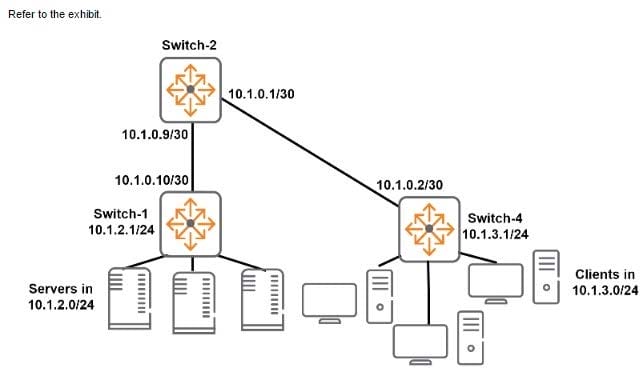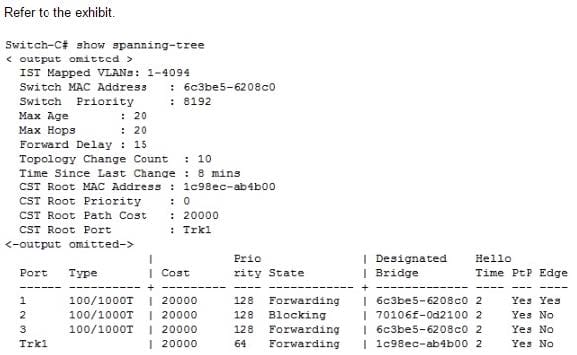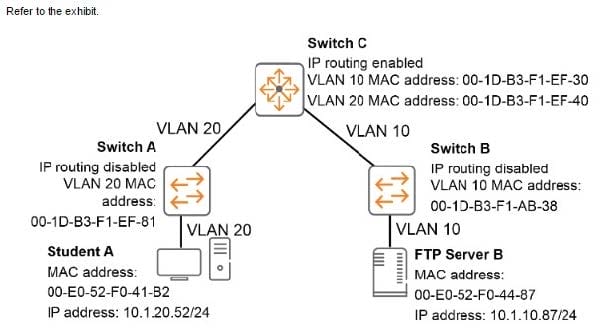HPE2-Z39 Online Practice Questions and Answers

The ArubaOS switch shown in the exhibit receives traffic with a VLAN 6 tag on switch port1. The traffic is
destined to a MAC address learned on port 2.
What does the switch do with the traffic?
A. It floods the traffic on port 2 on all VLANs.
B. It forwards the traffic on port 2 with a VLAN tag of 5.
C. It forwards the traffic on port 2 without a VLAN tag.
D. It drops the traffic

An ArubaOS switch has the routing table shown in the exhibit. A network administrator then enters this
command: Switch (config) # ip routs 10.0.0.0/8 10.1.104.2
After the administrator enters this command, packets arrive that are destined for 10.1.8.8 and 10.1.8.13.
What does the switch do with this traffic?
A. It load balances some of the traffic to 10.1.101.1 and some to 10.1.104.2.
B. It forwards at of the traffic to 10.1.104.2.
C. It drops the traffic.
D. It forwards all of the traffic to 10.1.101.1.

A network administrator creates a route to 10.1.2.0724 on Switch-4. What is the correct next hop for the route?
A. 10.1.0.2
B. 10.1.0.9
C. 10.1.0.1
D. 10.1.21

All switches are ArubaOS switches that currently have the default spanning tree priority. Switch-1 should be the root of the spanning tree If Switch-1 fails. Switch-2 should become root
Which configuration for spanning tree priorities ensures this behavior?
A. priority 15 on Switch-1 and priority 14 on Switch-2
B. priority 0 on Switch-1 and priority 15 on Switch-2
C. priority 0 on Switch-1 and priority 1 on Switch-2
D. priority 15 on Switch-1 and priority 9 on Switch-2

What is the result of this configuration?
A. The switch only adds the last static route entry to the routing table
B. All four routes are added to the routing table, but are never used.
C. The switch load shares connections across the four static next hops.
D. The switch only adds the last two static route entries to the routing table.
What is the effect if a network administrator sets a spanning tree priority on an ArubaOS switch interface?
A. The interface priority helps to determine which switch on the link is elected root.
B. The interface priority determines whether this switch or the connected switch has the Designated port on the link.
C. The interface priority breaks a tie when multiple interfaces offer the same lowest cost path to the root through the same neighbor
D. The interface priority prevents a rogue switch connected to the interface from becoming root.

Based on this ArubaOS switch output, what can a network administrator determine about the spanning tree topology?
A. Port 2 is an edge port
B. Port 3 will become the root port if the current root port becomes unavailable.
C. Switch-C is the root bridge of the topology.
D. Trk1 offers the lowest cost path to the common spanning tree root.
A network administrator needs to configure Virtual Switching Framework (VSF) for the first time on an ArubaOS switch. The administrator enters this command:

The administrator then wants to provision member 2 settings. What must the administrator do before provisioning these settings?
A. Specify the model type for member 1.
B. Configure SNMP settings that match settings configured on member 2
C. Join member 2 to the VSF fabric.
D. Enable VSF on the switch and reboot.
A network administrator wants to apply a critical PoE priority to any ArubaOS switch port that connects to an Aruba AR The priority should be applied dynamicaly based on LLDP messages received from the AP. Which step should the administrator take to meet this goal?
A. Configure the PoE usage setting on all ports as class and make sure that Aruba APs are defined as Class 4 devices.
B. Configure the PoE usage setting on all ports as tfdp.
C. Enable LLDP MED TLV extensions on the switch port.
D. Enable the default AP profile bound to the Aruba AP device type.

The Student A client needs to connect to FTP Server B. Student A sends the necessary ARP request and receives a reply. Which destination MAC address does the Student A client use in the FTP packet to FTP Server B?
A. 00-E0-52-F0-41-B2
B. 00-E0-52-F0-44-87
C. 00-1D-B3-F1-EF-81
D. 00-1D-B3-F1-EF-40